Top Challenges in Achieving High Procurement Performance


Achieving high procurement performance is a top priority for numerous successful businesses.
It’s the cornerstone of obtaining optimal value for goods and services, fostering a competitive advantage, and efficiently navigating through market unpredictability.
Still, achieving top-tier performance isn’t always a walk in the park.
There are many different challenges that may impact the overall efficiency of your procurement function, resulting in major operational and financial problems.
Today, we’ll be discussing these challenges, as well as examine real-life examples, and, most importantly, provide actionable tips for surmounting them.
By the end of this article, you’ll be ready to tackle any issues that may come your way and take your procurement performance to the next level.
The lack of accurate, complete, or timely procurement data can significantly impair decision-making, thereby affecting performance across all facets of the procurement function.
No real-time insight into inventory levels, for instance, can lead to either overstocking or stockouts, resulting in unnecessary costs as well as limited cash flow and storage space.
Similarly, not being aware of potential risks within the supply chain, such as geopolitical issues or natural disasters, may leave you ill-prepared to mitigate or respond to disruptions, thus jeopardizing your operations as a whole.
Even a lack of visibility into shipments can render you oblivious to delays up until they directly impact operations, causing missed production deadlines or unfulfilled customer orders.
It’s no surprise, then, that experienced CPOs prioritize the improvement of data quality.
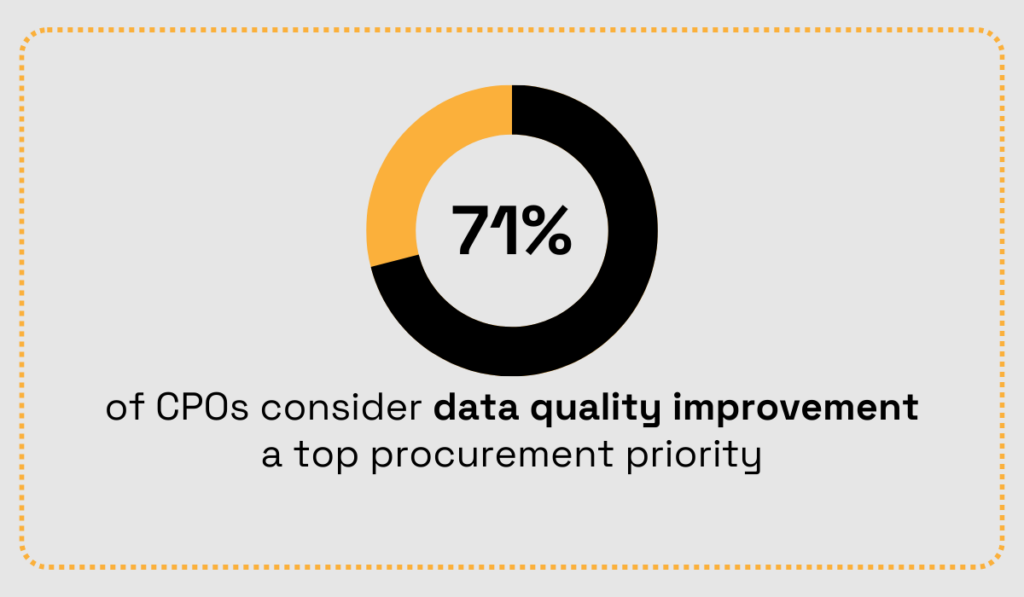
Illustration: Veridion / Data: Ivalua
They recognize that high-quality information directly translates to high-quality decisions and, in turn, great performance.
But, how can you ensure the quality of your data?
The short answer? Through technology.
By implementing automated procurement solutions such as, for instance, spend analysis software, e-procurement platforms, or supplier management systems, you can automate data capture, storage, and analysis processes.
This will ensure that your data is up-to-date, precise, and error-free at all times.
Take our procurement market intelligence solution, Veridion, for example.
With its AI-powered Match & Enrich API, it enables you to maintain a detailed and deduplicated Supplier Master Record, providing a highly accurate view of your supplier landscape.

Source: Veridion
Besides, Veridion also helps you stay ahead of potential risks by allowing you to define risk factors for each of your suppliers, and then alerting you about relevant changes in their business activities.

Source: Veridion
This guarantees a consistently fresh and comprehensive understanding of your suppliers’ dynamics.
All in all, data visibility is, in a way, the cornerstone of success in procurement.
Without it, you are essentially operating blindfolded, unaware of market fluctuations, supplier performance, and numerous other elements essential for informed decision-making and, ultimately, procurement excellence.
Inadequate communication, ineffective negotiation strategies, and supplier performance issues can significantly harm procurement performance as well as have serious consequences for companies as a whole.
Just take a look at Bakery Barn, a Pittsburgh-based protein bar maker that suffered a $3 million loss due to receiving collagen products contaminated with plastic and paper, according to the lawsuit they filed in Pennsylvania state court.
The lawsuit alleges that their supplier switched collagen sources without informing Bakery Barn’s procurement team and then engaged another company to blend the old and new collagen to maintain the texture Bakery Barn was used to, resulting in contamination due to negligence.
As per Talbot Underwriting Ltd., Bakery Barn’s insurer:
“To complete the blending process, [the company in charge of blending] cut open plastic bags of collagen directly over the blender, without using a screen, and pieces of plastic bag fell into the collagen mix.”
This case vividly illustrates how poor supplier performance and lack of communication can obstruct procurement from acquiring goods and services that meet company standards, leading to significant problems, from operational disruptions to substantial financial losses.
On the other hand, having reliable suppliers by your side, especially during challenging times, can be a real game-changer.
They can offer you better prices or delivery times, as well as keep you in the loop about any fluctuations in the market trends and demand.
Maybe it’s unsurprising, then, that in 2023, reevaluating supplier relations played a pivotal role in safeguarding businesses from economic uncertainty.
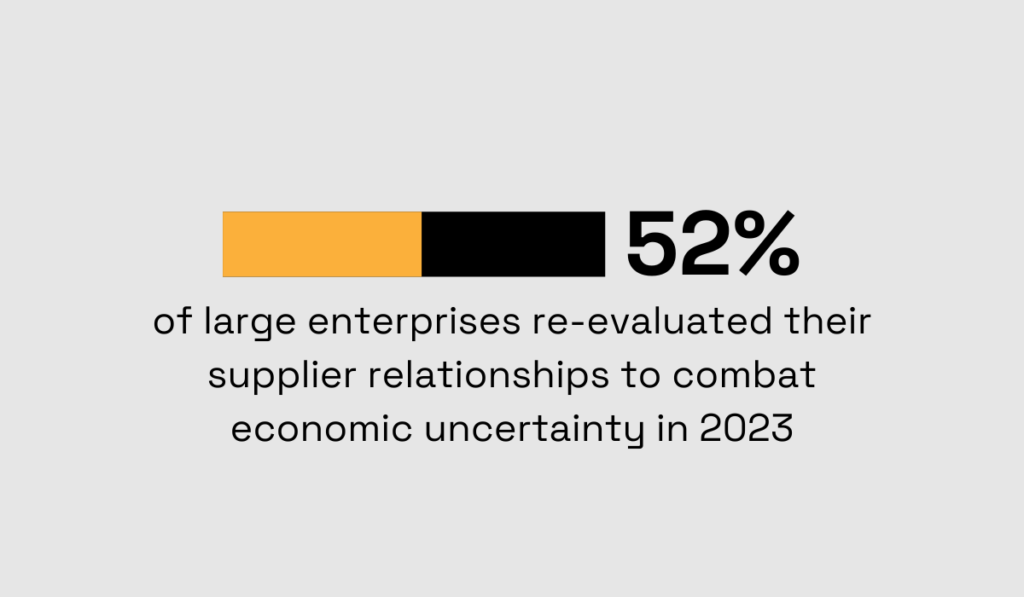
Illustration: Veridion / Data: Fictiv
The bottom line is this: the impact of suppliers on procurement performance is undeniable.
So, if your goal is to improve your supplier relationships and ensure better procurement outcomes, your safest bet is to utilize technology developed precisely for this purpose.
Supplier management systems streamline various supplier management processes, from onboarding and performance evaluations to order and contract management.
This enables you to analyze supplier efficiency, as well as facilitates more effective communication, and establishes transparency between you and your suppliers.
At the end of the day, successful supplier management is all about transforming your suppliers into strategic partners.
This not only opens doors to cost-saving opportunities but also ensures better procurement performance and resilience against market volatility.
Ensuring compliance with regulatory requirements or internal policies in procurement isn’t always easy, but it certainly is non-negotiable.
Failure to do so can lead to various consequences, including:
For instance, if you cancel a contract without any explanation or fail to pay on time, a supplier might sue the company for breach of contract.
But, beware: such situations often lead to more than just fines.
They can easily put a strain on your relations with suppliers, leaving them reluctant to work with you ever again.
What’s more, they might even spread the word about your poor procurement practices, leading to limited supplier options, higher prices, or lower-quality goods and services.
It’s important to remember that all these rules exist for a reason: to protect you and all stakeholders from risks.
Research indicates that a large majority of procurement professionals already understand this and dedicate a significant portion of their time to ensuring compliance.
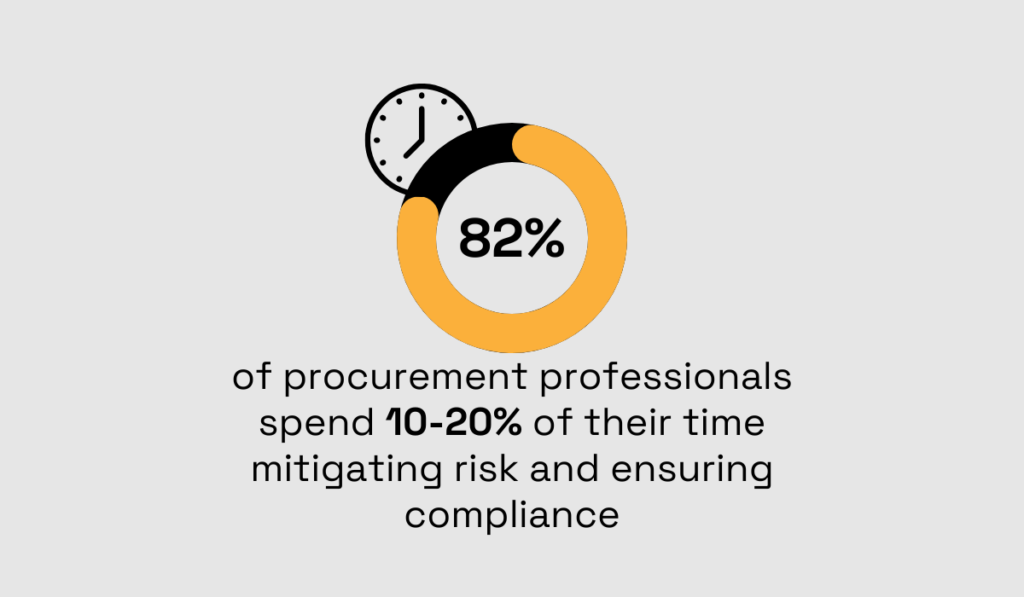
Illustration: Veridion / Data: Deloitte
They recognize it as essential to protecting procurement’s financial and operational well-being.
To avoid the problems mentioned above, it’s best to develop a robust framework for effective risk and compliance management.
This includes:
| Clear policies and procedures | To ensure consistent procurement activities |
| Regular employee training | To reinforce the importance of following rules and keep everyone updated on laws |
| Accurate record-keeping | To enhance transparency, accountability, and to demonstrate compliace |
| Frequent audits | To identify non-compliant areas for corrective action |
| Staying informed about industry developments | To adjust policies accordingly |
By adhering to such a well-defined system, you make sure that your procurement processes align with relevant rules, guidelines, and regulations, thereby minimizing risks and enabling your team to perform at its peak at all times.
Why leave compliance to chance when you can approach it proactively and address issues head-on before they even arise?
Fluctuations in raw material prices, exchange rates, and market demand can all impact your procurement planning and costs, making it quite challenging to maintain optimal procurement performance.
Take, for instance, the semiconductor shortage‘s effect on the automotive industry.
This scarcity not only prolonged procurement lead times for many businesses but also compelled procurement departments to reassess their strategies, dedicate additional time to sourcing new suppliers, and incur extra expenses, ultimately affecting both their budgets and operational efficiency.
One way to combat such challenges is to establish strategic partnerships with your suppliers, which allows both parties to navigate these difficulties together.
This is precisely what Jabil, a global manufacturing company, does.
They actively seek suppliers who won’t just deliver the goods they need, but also keep them in the loop about any market changes and trends.
Vishay, a supplier of passive components and semiconductors, is one such partner, as stated on Jabil’s website:
“Vishay specializes in the commodities that they’re supplying into Jabil, and we share target markets, such as high-reliability industrial, aerospace, medical and automotive. This makes their insight invaluable while assessing the current state of the market and planning for the future. Vishay consistently briefs Jabil on the latest component trends they see and the most cutting-edge technologies that they have available.”
This goes to show just how valuable having reliable partners can be.
However, they alone may not always be enough to ensure successful navigation through market unpredictability.
So, another good solution in this context would be leveraging data analytics tools.
They automatically gather and analyze pertinent information—both internal data concerning procurement processes and external information on market trends—and provide you with actionable insights for optimizing procurement strategy based on the prevailing market situation.
Ritesh Kumar, senior manager at the Smart Cube, concurs that being well-informed in today’s business landscape is a must:
“In an era characterized by unpredictability and macroeconomic events, being well-informed and agile is crucial for businesses, and preparing supply chains to mitigate risks and respond effectively to market fluctuations is paramount to maintain a competitive edge. Embracing the collaborative power of AI and human expertise empowers organizations to navigate challenges with foresight and adaptability, ensuring sustained success in today’s dynamic landscape.”
Using advanced technologies such as AI for data analysis is, essentially, the closest you can get to a crystal ball that tells you the future.
And today, the ability to tell the future is exactly what you need to ensure peak procurement performance.
Therefore, stay vigilant, form strategic alliances with your suppliers, and use the power of modern technology to tackle the uncertainties of the market with more confidence and ease.
The undeniable truth is that resisting change, whether in adopting new technology, procedures, or organizational structures, slows down improvement and negatively impacts procurement performance.
Throughout this article, we’ve mentioned several times how technology can be extremely beneficial for procurement.
Resisting it, therefore, directly translates to a missed chance to streamline operations, improve supplier relations, and stay on top of market trends.
Research backs this up, showing that 65% of companies view digitization as vital for achieving their procurement objectives.
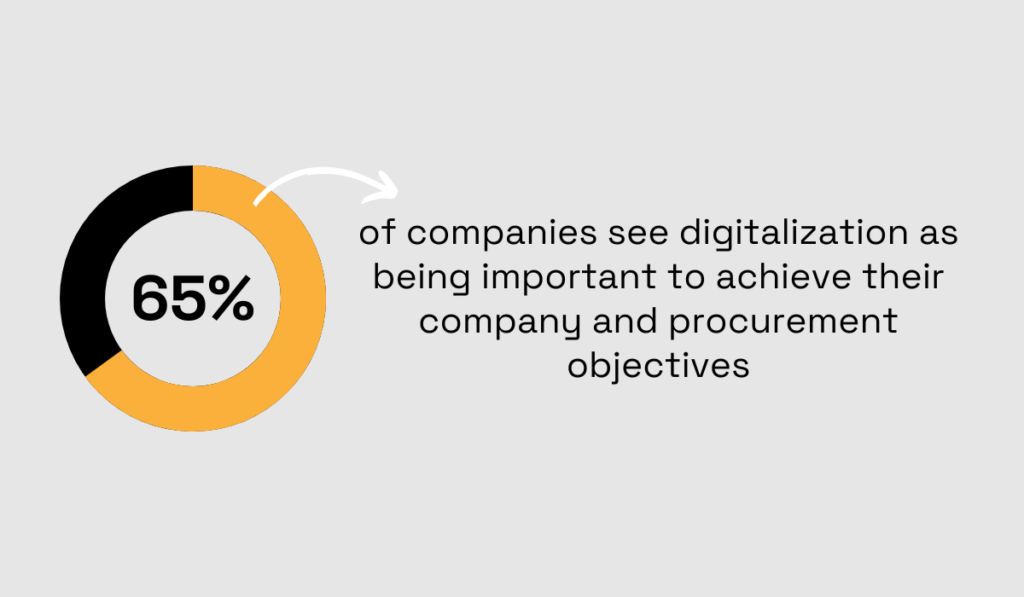
Illustration: Veridion / Data: ProcureTech
Yet, despite these overwhelming benefits, resistance still exists.
According to the Userlane survey, 25% of businesses across different industries experience resistance from employees to technology.
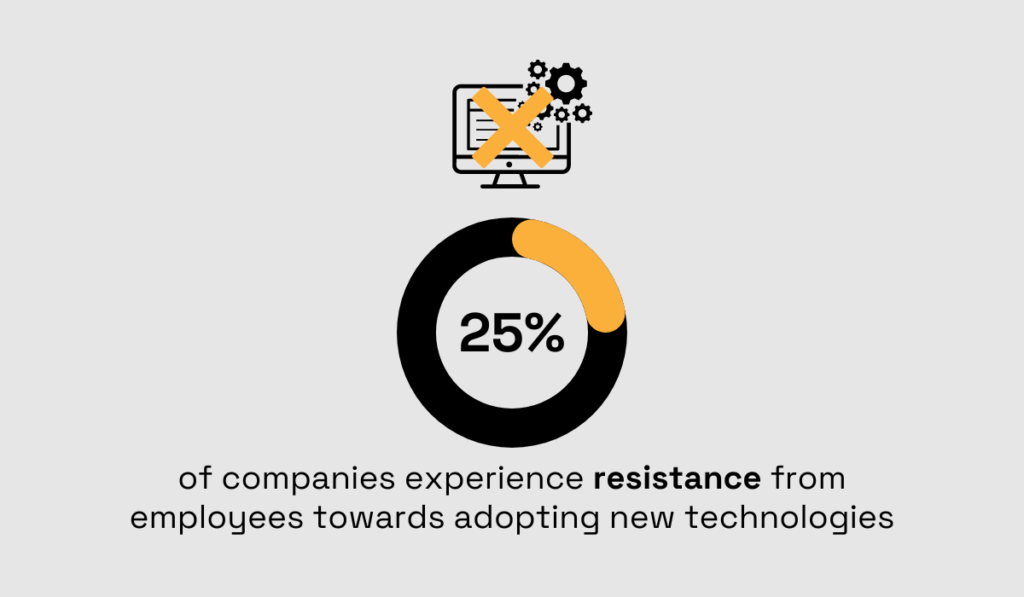
Illustration: Veridion / Data: Userlane
This poses a significant problem because, if your team is unwilling to embrace the change, you miss out on valuable opportunities to innovate and stay ahead of the competition.
So, how do you tackle this issue?
When it comes to the adoption of new processes and changes in general, many neglect the power of proper training and education.
People need to be adequately trained before they can feel comfortable with a new procedure or piece of technology.
This is supported by a Yooz survey, too, where respondents were asked about the main reason they feel unprepared to use new technologies.
This is what they had to say.
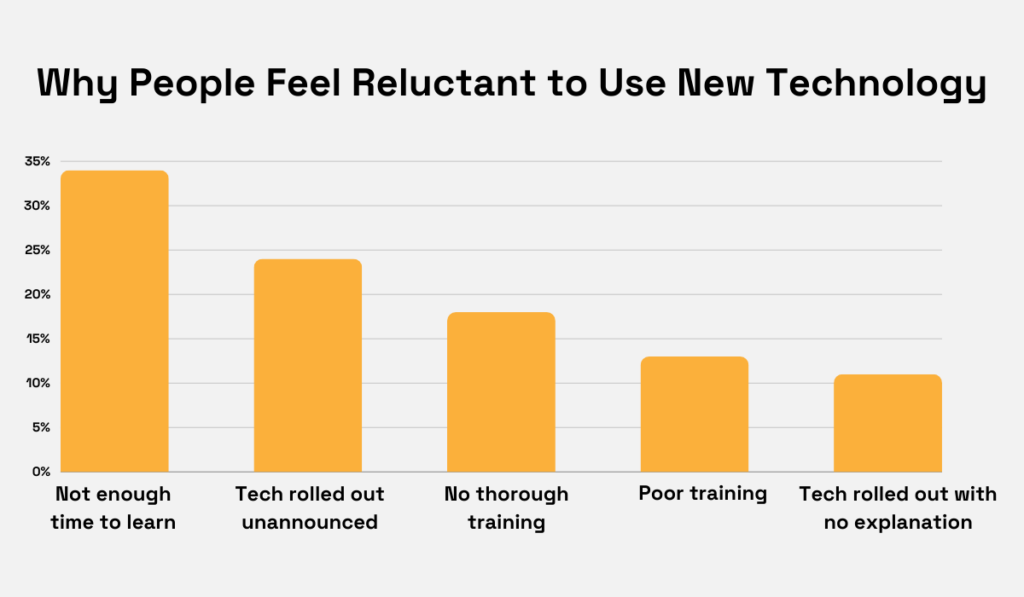
Illustration: Veridion / Data: Yooz
As you can see, most of the answers revolve around a lack of information or adequate training.
But the education you provide needs to be twofold.
Beyond just the obvious technical information about a particular software or method, you need to explain the rationale behind the change.
Talk to your team about why this innovation is so important, how it will improve their day-to-day, what’s expected from them, and so forth.
Procurement leader Greg Courts elaborates:

Source: LinkedIn
In other words, the team needs the “why-to” just as much as the “how-to.”
Only that way can you garner their support for the implementation.
If they understand the value of the change, they’ll be more likely not just to embrace it, but to make the most of it.
Procurement, in order to be successful, requires active involvement, engagement, and alignment from all relevant departments, including finance, operations, and executive leadership.
Without this collective effort, understanding company needs and delivering value to the business becomes almost impossible.
At the end of the day, how can you fulfill company requirements if you’re unaware of them?
The first step in attaining alignment among stakeholders is demonstrating the value of the procurement team.
Show your colleagues across different departments the data that unequivocally illustrates your team’s achievements and their positive impact on the business.
This may include highlighting cost savings, risk mitigation, enhanced efficiency, or improved product quality.
As Nicolas Walden, procurement advisory from the Hackett Group, emphasizes, procurement is rarely a top priority for businesses:
“Procurement is never top of the shopping list. Sales, Marketing, Business Development, and R&D are always top. So recognize that, and take the time to make your business case as persuasive as possible. Bring in the hard data, the benchmarks, the external perspectives on what everyone else is doing, and you should be doing the same.”
Therefore, it falls upon procurement professionals to change this perception and prove their value.
Another important thing to do is to communicate regularly and effectively with the stakeholders.
This includes conducting joint planning sessions to ensure everyone remains well-informed and to collaborate on setting goals.
By letting everyone be active participants in the planning process, the likelihood of meeting departmental objectives increases significantly.
In fact, research from Grammarly has already demonstrated that business leaders and workers alike agree that their productivity strongly depends on the stakeholders’ ability to express their needs efficiently.
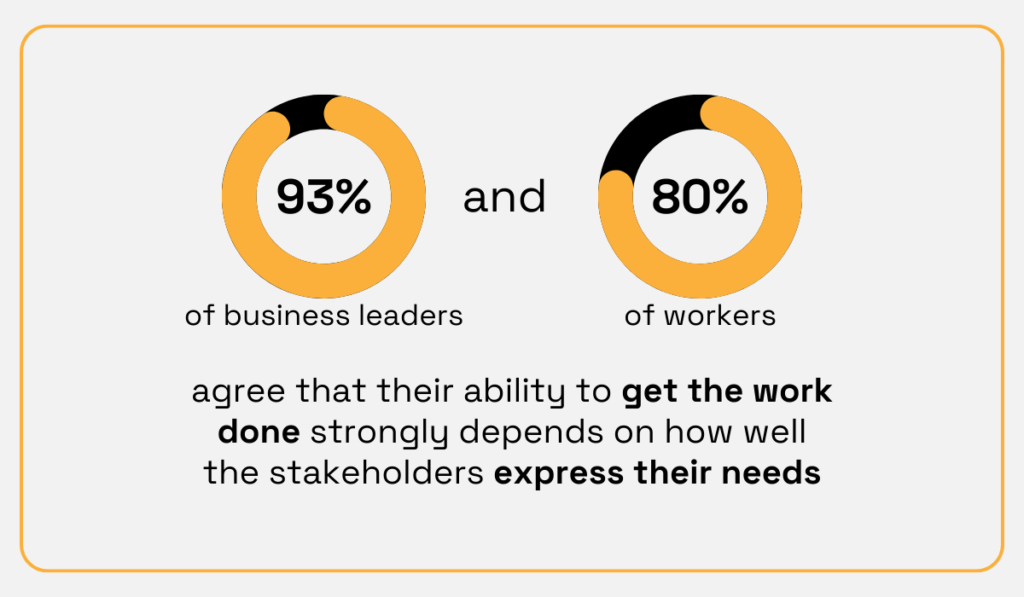
Illustration: Veridion / Data: Grammarly
Planning sessions are the perfect place to express these needs.
Overall, without stakeholder alignment, efficiency and performance suffer, not only within the procurement department but across the entire organization.
Luckily, such problems can be easily fixed. All it takes is a bit more communication and collaboration on both ends.
Ultimately, while achieving high procurement performance may be challenging, it’s still far from impossible.
With the right digital tools and the right team, it may even be a walk in the park after all.
Just make sure to always foster a culture of innovation, prioritize collaboration with the stakeholders, and treat your suppliers like the valuable partners that they are.
By doing so, you set the stage, not only for exceptional procurement performance but also for overall company success.